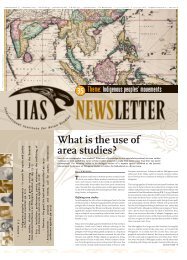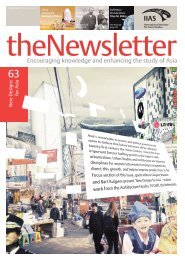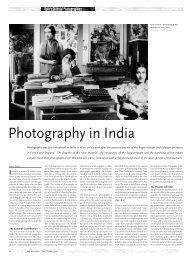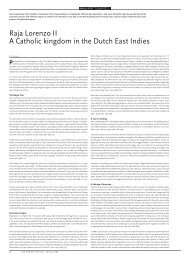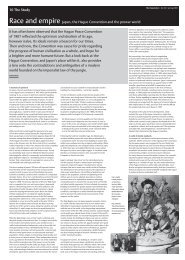Sex, love and revolution - IIAS
Sex, love and revolution - IIAS
Sex, love and revolution - IIAS
Create successful ePaper yourself
Turn your PDF publications into a flip-book with our unique Google optimized e-Paper software.
R E V I E W<br />
Kidambi, Prashant. 2007. The Making of an Indian Metropolis: Colonial Governance <strong>and</strong> Public Culture in Bombay, 1890-1920. Aldershot: Ashgate, Historical Urban<br />
Studies. 268 pp. ISBN 978 0 7546 5612 8 (hardback)<br />
Bombay on the brink of modernity<br />
Bombay, Kalbadevie Road, 1890.<br />
Hans Schenk<br />
The core of this book covers a rather short period of Bombay’s social history: 30 years that spanned<br />
the turn of the 20th century <strong>and</strong> included the late Victorian <strong>and</strong> Edwardian eras. Using an enormous<br />
amount <strong>and</strong> variety of primary <strong>and</strong> secondary sources, Kidambi analyses important changes in the relationship<br />
between society <strong>and</strong> local government.<br />
The plague <strong>and</strong> the poor<br />
After an introductory chapter on the 19th century, the author addresses three areas of governmental<br />
action: its responses to a major outbreak of plague, attempts to engage in social housing <strong>and</strong> restructuring<br />
of the local police. In Chapter 4, on fighting the bubonic plague epidemic of the late 1890s, Kidambi<br />
describes the two prevalent ways of approaching <strong>and</strong> fighting plague. The first addressed the disease as a<br />
product of locality-specific conditions of filth <strong>and</strong> squalor, while the second emphasised the human body<br />
as a disease-carrier that required quarantine. Kidambi presents a thorough, impressive <strong>and</strong> sophisticated<br />
essay on these two approaches, but he fails to point out the obvious role played by rats (<strong>and</strong> fleas). As Tindall<br />
writes in her book on Bombay, ‘the generally accepted view was that…it was rat-borne’ (page 253).<br />
The plague epidemic made local elites realise that the miserable <strong>and</strong> unhealthy living conditions of the<br />
urban poor had to be improved. That meant demolishing dilapidated slums <strong>and</strong> building social housing,<br />
a responsibility that fell to the Bombay Improvement Trust. Kidambi concludes, after another impressive<br />
<strong>and</strong> detailed analysis, that the Trust largely failed to improve housing <strong>and</strong> sanitary conditions of Bombay’s<br />
poor; it functioned more effectively in demolishing dilapidated houses than in creating new housing<br />
units. Hence the urban poor became more vulnerable in 1920 than they were a few decades earlier, while<br />
many remaining houses became even more overcrowded. Kidambi shows how the Trust became powerless<br />
in the power politics of a wide range of local elites, notably the propertied Indians.<br />
Though social housing proved to be woeful, Kidambi shows how sanitation practices, housing <strong>and</strong> the<br />
creation of a restructured police force transformed Bombay into a modern city according to the British<br />
model. The key to success was the increasing interventionist approach in urban governance in contrast to<br />
the erstwhile apathetic attitude among local rulers towards the growing ‘unintended’ city <strong>and</strong> its inhabitants.<br />
Civil society <strong>and</strong> the pre-G<strong>and</strong>hian roots of social service<br />
The author next addresses the growth of civil society <strong>and</strong> its institutionalisation. Many of the clubs, societies<br />
<strong>and</strong> trusts that proliferated were of what Kidambi calls a ‘hybrid’ organisational nature, combining<br />
voluntary <strong>and</strong> ascribed membership criteria. Some dwelled on caste or religion, while others were built<br />
upon Western norms of association <strong>and</strong> goals. Thus the emerging civil society showed a remarkable<br />
hodgepodge of organisations, through which Kidambi skilfully pilots the reader. He discusses a novel<br />
aspect of civil society: its educated elites began to participate in forms of social activism aimed at uplifting<br />
the masses. The term ‘social service’ is used in this respect, a term that is normally associated with<br />
G<strong>and</strong>hi but that should also invoke its pre-G<strong>and</strong>hian roots, such as those in Bombay. Moreover, Kidambi<br />
observes that the emerging practice of social service was undertaken not by members of empowered<br />
sections of local society, but by outsiders: the Anglophone intelligentsia took charge of this new social<br />
reform movement.<br />
Present-day societal characteristics <strong>and</strong> comparisons appear (surprisingly) in the conclusion. Comparisons<br />
of the failures of the Bombay Improvement Trust can be made with attempts by (semi)public bodies<br />
in independent India to house the urban poor, say, from the 1950s onwards. The tragic failures to act<br />
beyond demolishing the houses <strong>and</strong> huts of the urban poor <strong>and</strong> provide some sort of social housing<br />
reveal a macabre comparison to the failed civic consciousness of present-day local elites with those of<br />
Kidambi’s Bombay.<br />
Kidambi’s book is an excellent study. Bombay emerges as a modern Indian city ruled according to the<br />
Western norms <strong>and</strong> ideas of running a city <strong>and</strong> shaping its civil society. Any student of Indian urban<br />
history should read it, though it is not entirely without its faults, however minor they might be. Bombay<br />
was obviously not made between 1890 <strong>and</strong> 1920. It is even debatable whether these three decades form<br />
a ‘watershed era in Bombay’s evolution as a modern city’, as Kidambi claims (page 9). The city’s social<br />
history began in the 17th century, <strong>and</strong> the mid-19th century was a dramatic episode of industrialisation,<br />
technological development <strong>and</strong> adaptations to changing societal conditions. Dossal <strong>and</strong> Albuquerque<br />
show the impact of the Industrial Revolution on Bombay society, including the emergence of an industrial<br />
proletariat. The author could have given more attention to earlier economic foundations that influenced<br />
subsequent social changes. Nevertheless, Kidambi has written a fascinating book.<br />
References<br />
Albuquerque, Teresa. 1985. Urbs Prima in Indis, an Epoch in the History of Bombay, 1840-1865.<br />
New Delhi: Promilla.<br />
Dossal, Mariam. 1991. Imperial Designs <strong>and</strong> Indian Realities, The Planning of Bombay City 1845-1875.<br />
Bombay: Oxford.<br />
Tindall, Gilliam. 1982. City of Gold, the Biography of Bombay. London: Temple Smith.<br />
Dr Hans Schenk is a Professor at the AMIDSt Research Institute, University of Amsterdam.<br />
Schenk1937@planet.nl<br />
3 8 I I A S N E W S L E T T E R # 4 8 S u m m e r 2 0 0 8



